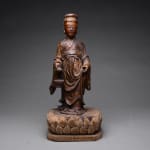Standing Wooden Figure, 1644 CE - 1911 CE
Wood
height 36.2 cm
height 14 1/4 in
height 14 1/4 in
PF.5159
Further images
The M’ing, founded in 1368 under the peasant emperor Hong Wu, was a militarily oriented socio-political entity much given to radical interpretations of Confucianism and with a very strong defensive...
The M’ing, founded in 1368 under the peasant emperor Hong Wu, was a militarily oriented socio-political entity much given to radical interpretations of Confucianism and with a very strong defensive ethos (the Great Wall dates to this period). However by the 17th century cracks had started to appear, young male heirs being manipulated as puppets by the ruling families, and the court became rotten with intrigue. To compound matters, the Manchurian Chinese cities were being attacked by local groups – dubbed the Manchus – who eventually invaded China and deposed the old regime. The last M’ing emperor, Chongzhen, hanged himself on Coal Hill overlooking the Forbidden City, bringing an end to his line and ushering in the Q’ing Dynasty.
The Q’ing had been founded by Nurhaci in the early 17th century, and persisted until the collapse of imperial China in 1912 with the hapless Pu-Yi, the last emperor of China. Their isolationist policies, social control (all men required to shave their heads, wear queues, and wear Manchu rather than traditional Chinese dress) introspection and cultural conservatism was at odds with their liberality in certain social issues – such as forbidding the binding of women’s feet (later withdrawn due to social pressure from the populace). However, this cultural inflexibility – which grew as the emperors grew increasingly unaware of the world outside their palace walls, much less the country’s borders – was a difficult stance to maintain in the shadow of the European thalassocracies, and it may have been this which helped hasten the demise of the Imperial system.
The Q’ing had been founded by Nurhaci in the early 17th century, and persisted until the collapse of imperial China in 1912 with the hapless Pu-Yi, the last emperor of China. Their isolationist policies, social control (all men required to shave their heads, wear queues, and wear Manchu rather than traditional Chinese dress) introspection and cultural conservatism was at odds with their liberality in certain social issues – such as forbidding the binding of women’s feet (later withdrawn due to social pressure from the populace). However, this cultural inflexibility – which grew as the emperors grew increasingly unaware of the world outside their palace walls, much less the country’s borders – was a difficult stance to maintain in the shadow of the European thalassocracies, and it may have been this which helped hasten the demise of the Imperial system.







